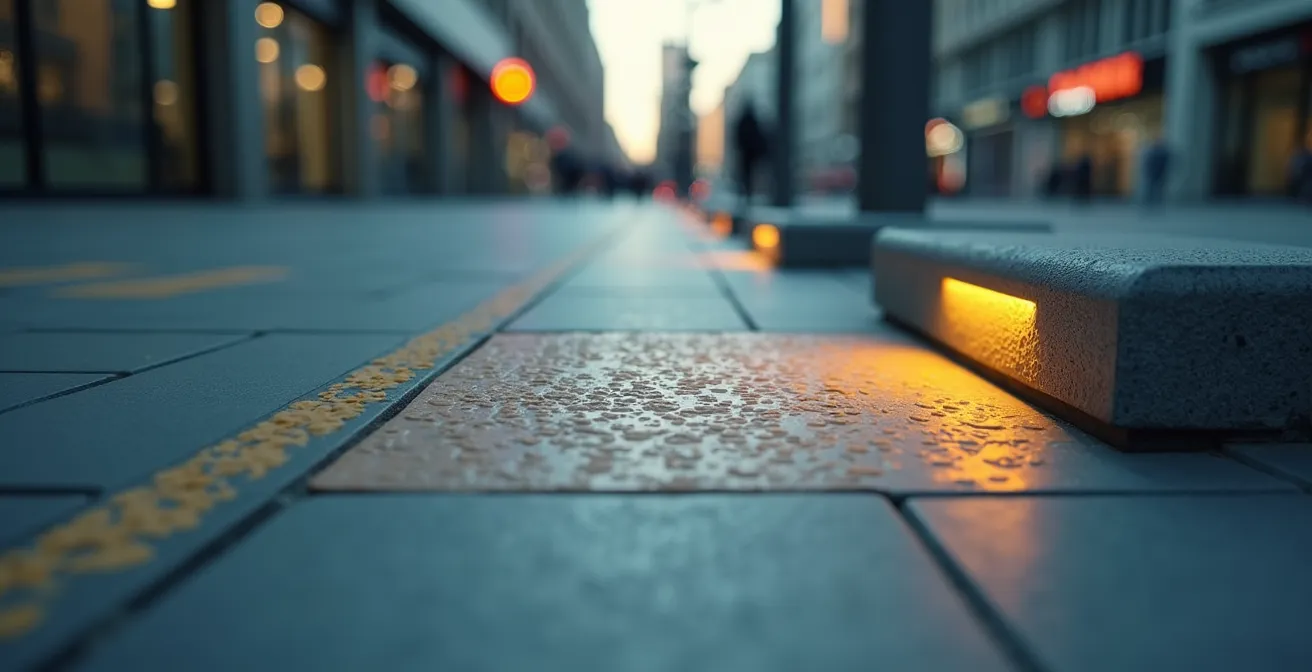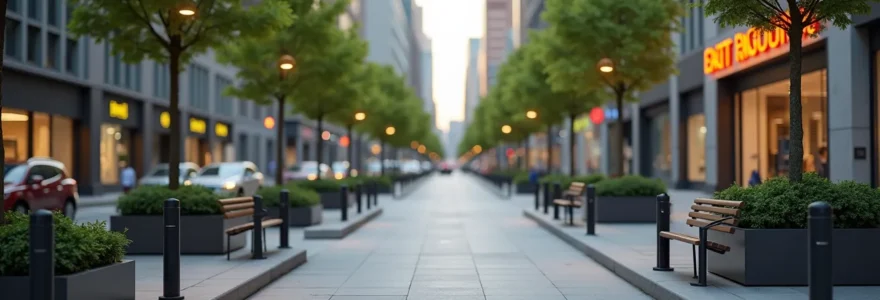When we think of street furniture, we often picture mundane objects: a simple park bench, a sturdy litter bin, or a protective bus shelter. For decades, these elements were passive additions to our urban landscapes, designed for basic convenience. However, a fundamental shift is underway. Today, urban planners and security experts recognize that these once-overlooked objects are powerful, active tools in a complex system of public safety. By moving beyond mere functionality, thoughtfully designed street furniture can orchestrate crowd movement, prevent accidents, deter crime, and even save lives.
This evolution transforms public spaces from collections of static items into dynamic, responsive environments. The strategic placement of a planter can guide pedestrian flow during a festival, the texture of a bollard can prevent a slip-and-fall accident, and integrated technology within a bench can provide real-time safety alerts. By understanding and leveraging these capabilities, we can build cities that are not just more livable, but fundamentally safer. The effective use of street furniture from procity.eu is no longer an afterthought—it’s a cornerstone of proactive urban security and a key element in creating secure, accessible, and vibrant public spaces.
Urban safety beyond the obvious
- Street furniture is an active system for managing urban safety, not just passive objects for convenience.
- Strategic design can control crowd dynamics, prevent everyday accidents, and mitigate hostile threats.
- Smart technology integrated into furniture is creating responsive, data-driven safety solutions.
- The psychological impact of furniture design can shape public behavior and deter anti-social activities.
Orchestrating movement: The tactical role of street furniture in crowd dynamics
In bustling city centers and during large-scale public events, the flow of people is not just a matter of convenience—it is a critical safety issue. Strategic street furniture acts as a subtle but effective tool for crowd management, guiding movement, preventing dangerous bottlenecks, and ensuring order. By designing layouts that channel pedestrian traffic, urban planners can dramatically improve the safety and efficiency of public spaces.
For concerts, festivals, and parades, specific furniture configurations can be deployed to control movement and maintain clear emergency access routes. Research into pedestrian dynamics has shown that well-placed furniture can lead to a 30% decrease in pedestrian congestion during peak events. Modular or movable items, such as planters and benches, can be rearranged to manage group sizes, reducing the risk of crushes in high-density zones. In emergencies, this same furniture can be repurposed as temporary barriers to guide evacuations or support public safety incidents, proving its dual value in everyday life and crisis situations.
Improving pedestrian safety during mass gatherings with modular street furniture
A case study of the Arafat to Muzdalifah road during the Hajj pilgrimage demonstrates how intelligently configured barriers and seating arrangements were crucial in managing massive crowd flows and facilitating emergency evacuations, showcasing the life-saving potential of tactical furniture placement.
Street furniture plays a crucial role in not just aesthetics but also the strategic control of crowd movement and safety during high-density urban events.
– Rania A. Raslan, Enhancing Urban Spaces through Crowd Behavior Analysis
To effectively leverage street furniture for crowd management, a systematic approach is necessary. Urban planners and event organizers can follow a clear set of steps to optimize public spaces for safety and flow.
Key steps for using street furniture to manage crowd density
- Step 1: Map pedestrian traffic patterns during events.
- Step 2: Design modular furniture layouts to channel flows.
- Step 3: Incorporate rapid-deploy barriers for emergencies.
- Step 4: Regularly assess crowd behavior to adjust furniture placement.
Beyond the visible threat: Street furniture’s function in preventing everyday accidents
While large-scale events present obvious challenges, the most common threats to public safety are often the mundane, everyday accidents. Slips, trips, and collisions are frequent occurrences in urban environments, but intelligent street furniture design can play a significant role in their prevention. By moving beyond aesthetics, furniture becomes an integral part of a safer pedestrian experience.
Incorporating simple yet effective features can yield significant results, with studies indicating a potential 25% reduction in pedestrian slip incidents with integrated furniture design that includes textured surfaces and proper drainage. Furthermore, furniture can serve as a powerful navigational aid, using design cues to delineate pathways, warn of elevation changes, or mark hazardous zones. For users with low vision, furniture that complements lighting or includes passive safety features is essential. The strategic placement of bollards and benches can also prevent accidental collisions at busy intersections, demonstrating the role of street furniture in urban safety.
How does furniture placement prevent accidents?
Strategic placement prevents accidents by clearly defining walkways, providing physical barriers from traffic, and incorporating materials and designs that reduce slips and falls.
The visual integration of safety features is key. Well-designed urban spaces seamlessly blend function and form, where safety elements enhance the environment rather than detract from it.

This image illustrates how textured paving provides essential grip, while the contrasting colors and logical placement of bollards and seating clearly guide pedestrians. This integrated approach not only mitigates hazards but also creates a more intuitive and comfortable journey for everyone.
The smart streetscape: Empowering urban safety through integrated furniture technology
The convergence of technology and urban design has given rise to the smart streetscape, where street furniture is no longer static but an active participant in public safety. As the smart street furniture market size reached USD 4.1 billion in 2024, cities are increasingly deploying furniture that thinks, senses, and communicates. This technological layer transforms benches, light poles, and kiosks into a distributed network for enhancing urban security.
These smart installations serve as data hubs, equipped with sensors to monitor foot traffic, air quality, and noise levels, providing valuable insights for urban planning and incident response. In an emergency, integrated digital displays can broadcast real-time alerts and evacuation instructions. Adaptive lighting systems mounted on furniture can respond to pedestrian presence, illuminating paths for safety while conserving energy. Many of these features are powered by sustainable sources like solar panels, ensuring their resilience and reducing their environmental footprint.
Integration of adaptive lighting in urban furniture for safety
A comprehensive study highlights how furniture-mounted adaptive lighting systems significantly reduce nighttime accidents and enhance pedestrian security in urban centers by dynamically adjusting illumination based on real-time conditions and movement.
Implementing these smart features requires a clear strategy to ensure they deliver tangible safety benefits. The focus should be on creating an integrated system that is both technologically advanced and citizen-centric.
Implementing smart safety features in street furniture
- Integrate sensors monitoring foot traffic and environmental conditions.
- Deploy digital displays for emergency alerts and public info.
- Utilize solar power for sustainable energy needs.
- Ensure adaptive lighting responds to ambient conditions and presence.
Shaping behavior: The psychological impact of furniture design on perceived and actual safety
Beyond physical and technological safeguards, street furniture exerts a powerful psychological influence on public behavior. The way a space is furnished can subtly encourage positive social interactions and deter anti-social activities, directly impacting both perceived and actual safety. This approach, rooted in principles of environmental psychology, uses design to shape a safer, more cohesive community.
One of the core concepts is “natural surveillance,” famously known as “eyes on the street.” Furniture arrangements that encourage people to sit, linger, and face public pathways increase the number of observers, naturally discouraging illicit behavior. Well-maintained, aesthetically pleasing furniture can also foster a sense of community ownership and stewardship, reducing vandalism. By creating clearly defined “zones of comfort” through seating clusters or “zones of risk” through more open, transient designs, planners can influence how people use and perceive the safety of a space.
Urban furniture design strongly influences social behavior and safety perception by promoting natural surveillance and community ownership.
– Jalilisadrabad et al., Rethinking Urban Furniture: A Review of Ecological and User-Centered Approaches
Effects of seating arrangements on community interaction and safety
Research into different urban furniture layouts shows a direct correlation between design and user behavior. Arrangements that facilitate conversation and group seating enhance perceived security and social cohesion, while isolating designs can contribute to feelings of unease.
To harness this psychological impact, designers can adhere to several key principles that reinforce positive public behavior and enhance the feeling of safety without overt security measures.
Design principles to enhance safety perception with furniture
- Place furniture to encourage ‘eyes on the street’.
- Design to foster territoriality and community stewardship.
- Maintain high aesthetic and functional standards.
- Create distinct comfort and risk zones through arrangement.
Key takeaways
- Strategic street furniture is a proactive tool for orchestrating crowd flow and enhancing event safety.
- Intelligent design choices in furniture can significantly reduce everyday accidents like slips, trips, and falls.
- Smart technologies embedded in furniture create a responsive network for data collection and emergency communication.
- The psychological impact of furniture placement can deter crime and foster a strong sense of community safety.
- Hostile Vehicle Mitigation can be seamlessly integrated into aesthetic designs, balancing security with public usability.
Stealth security: Advanced hostile vehicle mitigation woven into urban fabric
In an era of evolving security threats, protecting public spaces from hostile vehicles is a paramount concern. However, the solution does not have to be a landscape of imposing concrete barriers. The new frontier of Hostile Vehicle Mitigation (HVM) focuses on “stealth security,” where protective elements are seamlessly and aesthetically woven into the urban fabric. This approach ensures robust protection without creating a fortress-like, unwelcoming environment.
Innovative designs now allow everyday street furniture to serve a dual purpose. Reinforced planters, specially engineered public seating, and even large-scale art installations can function as impact-resistant barriers capable of stopping a multi-ton vehicle. As the UK’s National Protective Security Authority (NPSA) emphasizes in its Public Realm Design Guide, the goal is to balance safety with the functional and aesthetic demands of a vibrant public space. This requires a sophisticated understanding of material science and discreet deployment strategies to ensure safety standards are met without compromising the user experience. You can Discover all benefits of street furniture that contribute to a safer and more cohesive community.
The choice of materials is critical in balancing strength, weight, and visual impact. Advances in material science provide planners with more options than ever before to create effective yet unobtrusive HVM solutions.
| Material | Strength | Weight | Aesthetic Impact |
|---|---|---|---|
| Steel | High | Heavy | Industrial look |
| Composite | Medium | Lightweight | Customizable finish |
| Concrete | Very High | Very Heavy | Robust but bulky |
Integrating these advanced security measures discreetly is both an art and a science, requiring adherence to best practices that prioritize both safety and public space quality.
Best practices for discreet HVM integration
- Incorporate HVM elements within standard street furniture forms.
- Choose high-strength, lightweight materials for ease of installation.
- Ensure compliance with ISO 22343 and PAS 68 safety standards.
- Balance security requirements with public usability and aesthetics.
Frequently Asked Questions on Urban Safety Furniture
What is hostile vehicle mitigation (HVM) furniture?
HVM furniture refers to items like bollards, planters, and benches that are specially engineered and reinforced to act as protective barriers. They are designed to stop or disable a vehicle used in a hostile attack, protecting pedestrian areas and buildings while blending into the urban landscape.
How does ‘smart’ furniture improve safety?
Smart furniture improves safety by embedding technology like sensors, cameras, and connectivity. This allows it to monitor environmental conditions, track foot traffic, provide emergency alerts via digital screens, offer public Wi-Fi, and use adaptive lighting to enhance visibility and security in real-time.
Can street furniture really influence public behavior?
Yes. Based on principles of environmental design and psychology, the placement and style of street furniture can significantly influence behavior. It can encourage “eyes on the street” to deter crime, foster a sense of community ownership that reduces vandalism, and guide pedestrian flow to prevent overcrowding.
